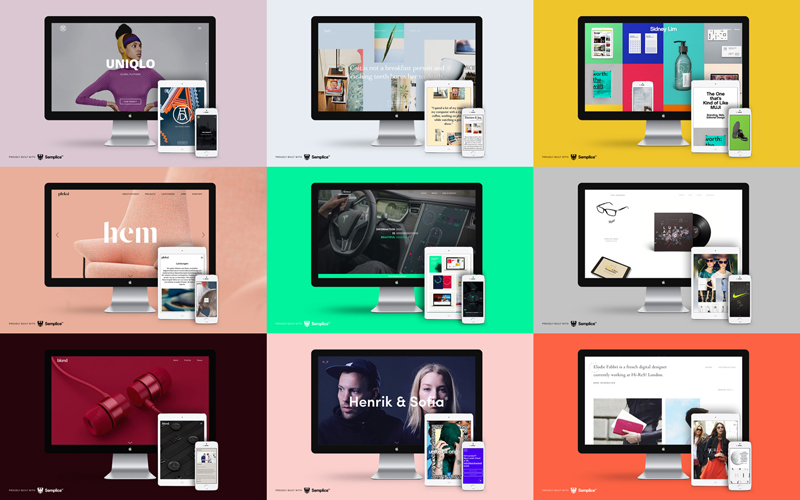Still don’t have the job you really want? The problem may be your portfolio. Tobias van Schneider, co-founder of Semplice, shares what could be wrong—and how to make it better.

You built an online portfolio for your design work. You wrote a nice cover letter and sent it off to what feels like countless companies. You followed up with friendly emails and even personalized gifts that would make you want to hire yourself on the spot.
So why don’t you have a job offer yet?
Often, the job hunt simply requires patience. But if it feels like you’ve been trying and waiting forever with zero luck, the problem may be your portfolio. Here’s what could be wrong.
You’re Not Curating Your Projects
It’s tempting to dump every project you’ve ever touched in your portfolio to make it feel full and impressive, but that only drags your better work down. Instead of filling your portfolio with fluff, choose only the projects that make you proud. Curate and let your best work shine.
When a recruiter or senior designer is reviewing dozens or even hundreds of portfolios a week, you can imagine they don’t spend much time on any one of them. The first 2-3 seconds on your page count the most. In those 2-3 seconds they will decide if they jump to the next portfolio or stay a bit longer and browse your work. Optimizing your overview and curating your projects can mean the difference between getting that closer look, or getting dismissed within seconds.
You’re Not Selling Yourself (in Addition to Your Work) Enough
With our portfolio, we tend to assume our work will speak for itself. But it’s not just about your work, it’s about you. Your potential employers or clients want to know who you are: How you think, what it would be like working with you, whether you work well with a team. Sometimes, that’s even more important than your experience and skill.
These are all qualities you can convey in your About page and project case studies.
Your About page is the most important page on your portfolio. Most people’s first instinct is to navigate to this page to get some idea of who you are before they browse your work. Of course you should include your name and email address on your About page, but don’t be afraid to show some personality here too. Add a photo of you at work. If you’re funny, crack a joke. Regardless of whether you’re funny, write in your voice and be yourself. Your About page should make readers feel like they’ve had a quick lunch with you. It should be brief, pleasant and memorable.
Case studies not only provide context for your projects (which is crucial), but also give the reader a glimpse into both your thought process and personality. Write brief but insightful case studies that let the reader know how you approached a project, your thought process along the way and your feelings about the final result. Sell both your work and yourself.
You’re Not Showing Enough Experience
Maybe you’re a young designer, or perhaps you’re just trying to break into a new area of design. In any case, it’s a given that whoever is reviewing your portfolio wants to feel confident your style and skill is the right fit for the job.
If you don’t have the right projects to show, try doing more personal side projects that will boost your portfolio. Volunteer to do design work for a nonprofit organization. Choose a company you admire and do an unsolicited redesign (but beware of too many unsolicited designs or cliches like Nike redesigns ). Ask a friend with more experience to bring you in on a relevant project. If you don’t have the right work to show yet, be willing to put in the work until you do.
Related: How to Create Amazing Design Portfolio Projects | How to Choose the Right Side Projects | 6 Side Projects Turned Popular Tools for Designers, Part 1
You’re Confusing Your Visitor
Especially when you’re early in your career, chances are that your portfolio is full of experimental work or work from different disciplines. Generally there is nothing wrong with showing diverse skills, but it could be why people are passed on for the jobs they want.
Remember, our portfolio is not only about the work we’ve done, but what we want to do in the future. So if you’re hoping to land a specific job, curate for that job. Likewise if you’re trying to avoid a certain style or type of work.
If I see you have two website projects, one branding project, one film project and another analog painting project in your portfolio, I simply do not know in which category to put you. Chances are high that the company reviewing your portfolio assumes you’re too all over the place and doesn’t understand what you’re good at, or what you want to do. It’s not that your work is bad, but that your portfolio leaves too many open questions.
If you think that might be the case for you, clean up your portfolio and focus on the work you want to do in the future. If you want to do web design, get rid of everything else (unless that something else is really impressive). If that makes your portfolio feel empty, work on adding one or two more web design projects by doing side projects as mentioned above. Give those who review your portfolio the impression that you know what you want, and that you know where your skill lies.
Your Portfolio Needs a Refresh
It’s possible your portfolio simply needs improvement. Your website is as much a display of your skill as your actual projects, so design it with love. This is not to say your portfolio should be a work of art, but it should showcase your projects brilliantly. That means no outdated design templates, confusing navigation, broken links, sloppy writing, distracting animations or other elements that make your visitor think about anything but you and your work.
–
In the creative industry, a portfolio is one of the key factors in getting new work. As I’ve learned from my “ How to get a job at X” series, most companies are not even considering candidates without a portfolio. Until you have the job you want, make it your job to improve your portfolio. Look at your website from the perspective of the person you want to hire you. Make it easy for them to choose you.









I have just read over your article Tobias on improving your portfolio and could not agree more.